Overview
The article presents an authoritative step-by-step guide on providing notice to an employer. It underscores the critical importance of understanding notice periods, maintaining professionalism, and adhering to effective communication practices. By detailing the factors that influence notice lengths, the article highlights the significance of clear communication during resignations. Furthermore, it emphasizes the necessity of managing workloads and relationships throughout the notice period to ensure a smooth transition and to safeguard future career opportunities.
Key Highlights:
- A notice period is the time an employee must continue working after resigning, typically ranging from two weeks to a month based on company policy and role.
- Understanding your notice period is critical for professionalism and allows employers time to find a replacement.
- In 2025, the average notice period in the U.S. remains stable, with most companies expecting a two-week notice, though this varies by industry and role.
- Factors influencing notice period length include company policy, role seniority, current projects, industry standards, and personal circumstances.
- Employees should review their employment contracts and state laws to understand their rights and obligations regarding resignation.
- Effective resignation communication involves scheduling a meeting with a supervisor, expressing gratitude, and submitting a formal resignation letter.
- During the notice period, employees should manage their workload, maintain open communication, and prioritize the completion of ongoing projects.
- Common scenarios during the notice period include being asked to leave early, taking leave, increased workload, and receiving counter-offers from employers.
- Maintaining professionalism during resignation is essential for preserving future career opportunities and networking relationships.
- After resigning, employees should update their resumes, network, research job opportunities, prepare for interviews, and consider further education.
Introduction
In the complex landscape of employment, understanding the nuances of notice periods is not just important; it is essential for both employees and employers. A notice period serves as a critical element in facilitating a smooth transition when an employee chooses to resign.
While average notice periods in the U.S. typically hover around two weeks, expectations can vary significantly based on:
- Industry standards
- Individual roles
- Company policies
As the workforce evolves, particularly in the wake of trends like the ‘Great Resignation,’ comprehending the implications of notice periods becomes vital for maintaining professionalism and fostering positive relationships.
This article delves into the intricacies of notice periods, offering insights into:
- Factors influencing their length
- Legal obligations
- Effective communication strategies
- Best practices for leaving on good terms
Ultimately, it guides employees through this critical phase of their career journey.
Understanding Notice Periods: What You Need to Know
A notification duration refers to the time a worker is obligated to continue working after officially resigning. This duration typically ranges from two weeks to a month, influenced by company policy and the employee’s specific role. Comprehending your timeframe for departure is essential; it not only reflects professionalism but also underscores the importance of providing notice to your employer.
This period allows the organization sufficient time to locate an appropriate substitute and enables a seamless transfer of duties.
In 2025, the average advance time in the U.S. remains stable, with most companies anticipating a two-week lead. However, this can vary significantly based on industry standards and individual employment contracts. Certain roles, especially in leadership positions or niche areas, may require a more extended advance time to ensure a smooth transition of responsibilities.
Familiarity with your employment agreement or company manual is crucial to ascertain the exact advance time relevant to your circumstances. Many HR professionals emphasize that adhering to these terms is not just a contractual obligation but also a reflection of your professionalism. As industry specialists highlight, providing notice to your employer in advance is a critical element of sustaining favorable relationships, which can influence future recommendations and career prospects.
Kim Parker emphasizes that most workers who left a job in 2021 cited insufficient wages, lack of advancement opportunities, and feeling undervalued as primary reasons, underscoring the necessity of understanding staff motivations in relation to resignation timelines.
The significance of resignation timelines is accentuated by broader job market trends, such as the recent ‘Great Resignation,’ where numerous individuals are reassessing their career paths. Although resignation rates have increased, understanding the implications of notification durations is essential for both staff and employers when providing notice to their employer. Organizations with clear advance time policies often find that these practices enhance workplace morale and foster a culture of respect.
The Job Openings and Labor Turnover Survey, which encompasses approximately 21,000 businesses, suggests that these trends reflect a changing employment environment.
In practice, workers generally provide advance warning ranging from two weeks to a month before departing from a position, depending on their role and the organization’s expectations. For instance, tech companies may have typical advance times of two weeks, while legal professions might necessitate a month or longer. By recognizing and adhering to these norms, employees can ensure they leave their positions on good terms, paving the way for future opportunities.
Furthermore, firms such as Google and Deloitte have established standard timeframes that align with industry expectations, offering additional context for HR managers to consider.
Factors Influencing Your Notice Period: How to Determine the Right Length
Several factors can significantly influence the length of your notice period:
- Company Policy: Organizations differ significantly in their regulations concerning advance notification. It is essential to consult your employee handbook or HR department to understand the specific requirements that apply to your situation before giving notice to your employer.
- Role and Seniority: Generally, elevated positions require extended advance time. This is due to the complexity and essential nature of the responsibilities involved, which often necessitate a longer transition phase to ensure continuity.
- Current Projects: If you are engaged in key projects, it is crucial to assess how your departure might impact these initiatives. Engaging in conversations with your manager regarding your duties can assist in identifying a suitable timeframe to give notice to your employer that minimizes disruption.
- Industry Standards: Various sectors have set guidelines concerning advance notifications. For instance, management and professional roles often have longer median tenures, averaging around 4.8 years, compared to service occupations, which average only 2.7 years. Researching typical practices in your field can provide valuable context for your decision. The case study named “Occupational Variations in Employee Tenure” emphasizes these differences, demonstrating how tenure can impact period expectations.
- Personal Circumstances: Your individual situation, such as a new job offer or relocation, may also affect how much warning you can realistically give. It is key to balance personal needs with professional obligations, particularly when you give notice to your employer.
Understanding these factors can help you navigate the resignation process more effectively, ensuring that you leave on good terms while fulfilling your professional obligations.
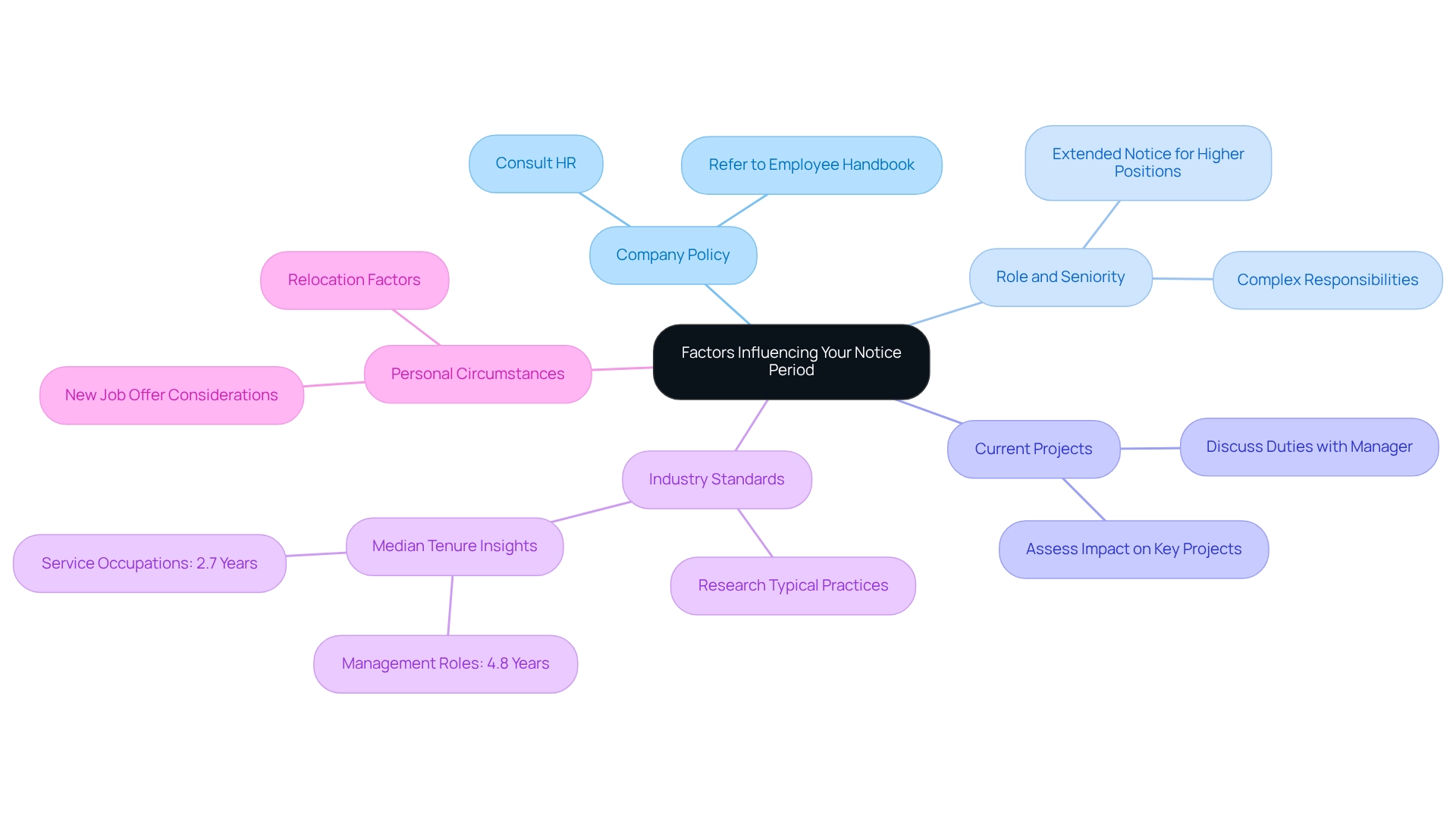
Legal and Contractual Obligations: Know Your Rights When Resigning
When stepping down, it is crucial to understand your legal and contractual responsibilities to facilitate a smooth transition:
- Employment Contract: Begin by examining your employment agreement for any clauses related to resignation and notification durations. Understanding these concepts is essential, as violating them may lead to legal consequences or loss of advantages.
- State Laws: Each state has its own regulations concerning employment termination and the requirement to notify the employer, significantly influencing your resignation process. For instance, in Nebraska, a rule or regulation implemented after the rental agreement is enforceable if adequate warning is provided and it doesn’t significantly alter the agreement. Familiarizing yourself with these laws will empower you to navigate your rights and responsibilities effectively.
- Final Paycheck: Be aware of your rights regarding your final paycheck and any accrued benefits, such as vacation pay. Knowing what you are entitled to can prevent misunderstandings and ensure you receive what you deserve.
- Non-Compete Clauses: If your contract includes a non-compete clause, understanding its implications on your future employment opportunities is vital. These clauses can restrict your ability to work in your field after leaving, making clarity on this matter essential.
- Consult with HR: If uncertainties arise about your rights or the resignation process, do not hesitate to consult with your HR department. They can provide valuable insights and guidance tailored to your situation.
- Document Communications: Maintain a record of all communications regarding your resignation. This documentation can serve as a reference in the event of conflicts or misconceptions in the future.
- Consider Flexible Timeframes: Some companies, particularly in retail, have adopted flexible timeframes to accommodate staffing needs during peak periods. For example, retail businesses may implement adaptable notification times to ensure prompt coverage during busy times, allowing for swift recruitment or shift adjustments. This approach can facilitate a smoother transition for both parties.
- Understand Typical Notice Periods: Upon deciding to leave a job, it is imperative to notify your employer, with the notice period varying from two weeks to several months, depending on your role and company policy. Being aware of these expectations can aid in planning your resignation accordingly.
- Importance of Performance Management: As experts highlight, effective management of the resignation process is crucial for maintaining workplace morale and ensuring a smooth transition. Keeping this in mind can enhance your departure experience.
- Stay Informed on Employment Regulations: Recent discussions, such as OPM receiving 78 comments on proposed regulations, indicate ongoing changes in employment laws that may impact HR practices. Staying informed about these developments can help you adapt your strategies effectively.
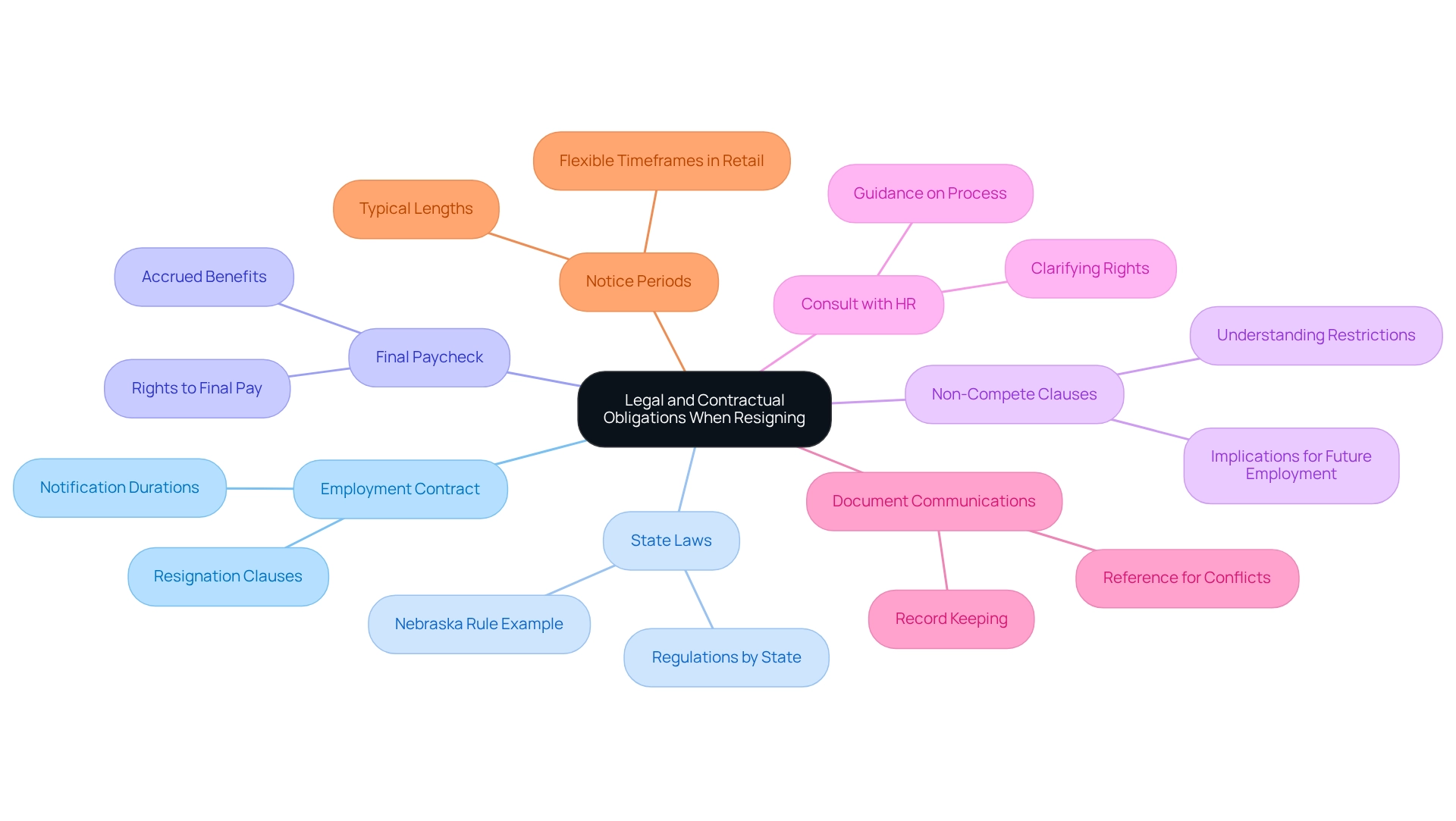
How to Communicate Your Resignation: Best Practices for Informing Your Employer
Communicating your resignation effectively is essential for leaving on good terms and preserving professional relationships.
- Schedule a Meeting: Initiate a private meeting with your supervisor to discuss your resignation in person. This demonstrates respect and professionalism, setting a positive tone for your departure.
- Prepare your message by clearly articulating your intention to resign and providing your employer with notice regarding your last working day. Keep your message concise and maintain a positive outlook, focusing on your experiences rather than any negatives.
- Express Gratitude: Acknowledge the opportunities you’ve had during your tenure by thanking your employer. This gesture fosters goodwill and can help maintain a positive relationship post-resignation.
- After your meeting, submit a formal resignation letter that reiterates your last working day and expresses your appreciation for the support you received. This formalizes your resignation and serves as a record.
- Be Open to Discussion: Be prepared for potential questions or even a counter-offer. Approach these discussions calmly and professionally, regardless of the response.
Example Resignation Letter:
[Your Name]
[Your Address]
[City, State, Zip]
[Email Address]
[Phone Number]
[Date]
[Manager's Name]
[Company Name]
[Company Address]
[City, State, Zip]
Dear [Manager's Name],
I am writing to formally resign from my position at [Company Name], effective [Last Working Day]. I appreciate the opportunities for professional and personal development that you have provided me during my time here. Thank you for your support and guidance.
Sincerely,
[Your Name]
Effective communication during the resignation process can significantly impact employer-employee relationships. Research indicates that companies with strong communication practices can enhance staff retention by up to 4.5 times compared to those with poor communication. This underscores the importance of clear and respectful dialogue when resigning.
Moreover, recognizing that 33.2% of leaders link staff departures to mental health factors highlights the necessity for sensitivity in these discussions. By adhering to these best practices, you can ensure a smooth transition and leave a lasting positive impression. As McKinsey states, “If you communicate effectively with your employees, you can boost their productivity,” reinforcing the broader impact of effective communication in workplace dynamics.
Additionally, recognizing trends such as postgraduate degree holders being the least likely to report quitting their jobs in 2021 provides further context on current job market dynamics. By integrating these insights, you can navigate your resignation with greater awareness and professionalism.
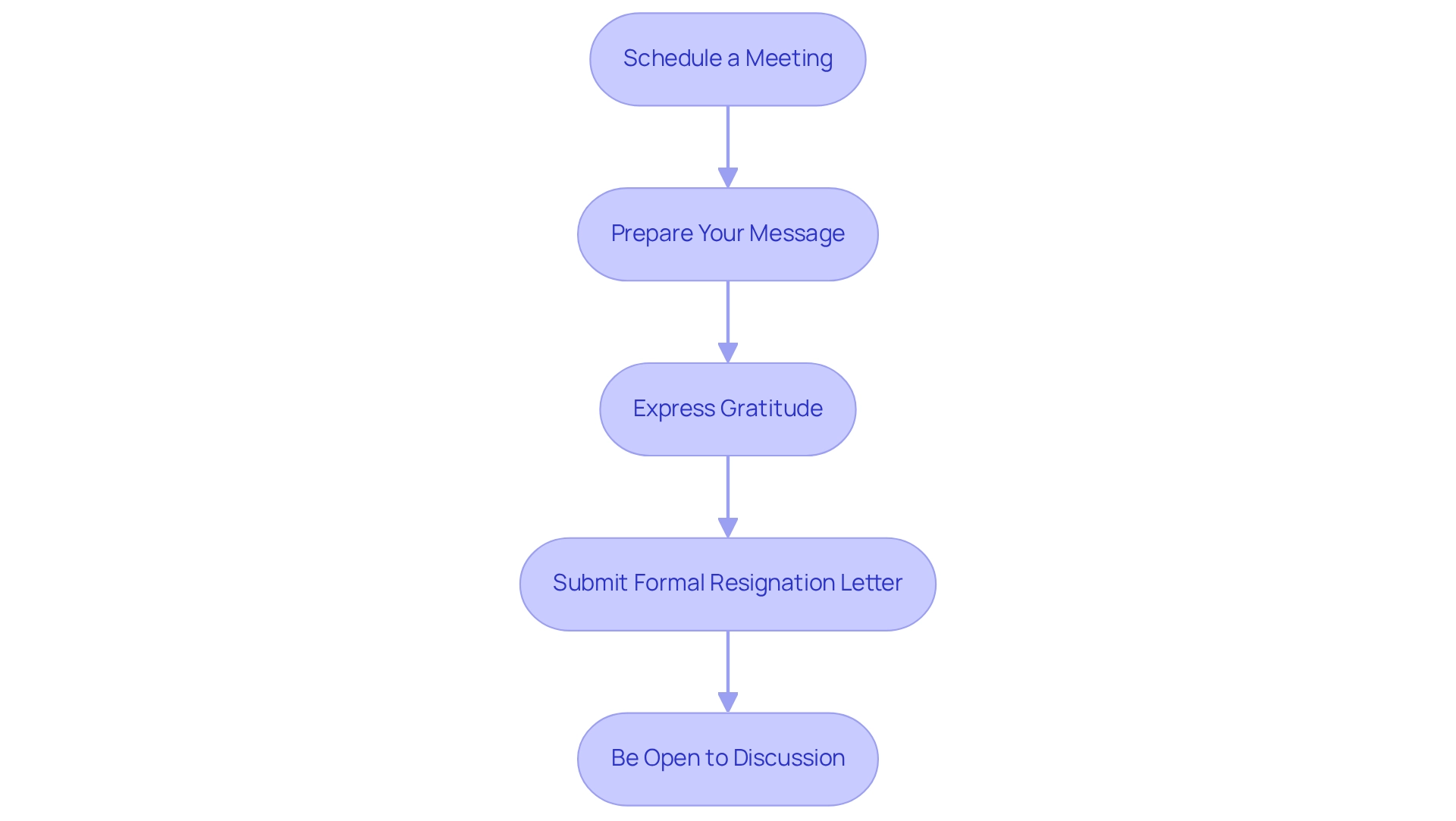
Navigating Your Notice Period: Expectations and Challenges
During your notice period, you may encounter various expectations and challenges that require careful navigation:
- Workload Management: Effectively managing your workload is crucial as you transition responsibilities to colleagues. Document your tasks meticulously and prepare comprehensive handover notes to ensure a smooth transfer of duties. The duration of notification times can differ greatly, from two weeks to several months, which can influence how you give notice to your employer and handle your remaining time. For instance, a reduced timeframe may necessitate more thorough planning to ensure that all duties are properly transferred.
- Emotional Dynamics: Leaving a job often brings a mix of emotions. According to Kim Parker, “the majority of workers who quit a job in 2021 cite low pay, no opportunities for advancement, feeling disrespected.” This underscores the emotional difficulties many encounter during their transition phase. It’s essential to stay focused on your work and maintain professionalism, even if feelings of frustration arise, as these emotions can affect productivity and workplace relationships.
- Communication: Keeping lines of communication open with your manager and team is vital. Regularly update them on your progress and any outstanding tasks to foster a collaborative environment during your transition.
- Final Projects: If you are involved in ongoing projects, prioritize completing your responsibilities to the best of your ability. This commitment not only reflects your professionalism but also helps maintain the quality of work expected by your employer.
Tips for Success:
- Stay Positive: Concentrate on the positive aspects of your time at the company, which can help mitigate any negative feelings.
- Be Helpful: Offer to assist in training your replacement or documenting processes, showcasing your dedication to a smooth transition.
- Maintain Professionalism: Avoid negative comments about the company or colleagues, as this can tarnish your reputation and future opportunities.
Navigating a transition phase can be challenging. However, with the appropriate strategies, you can depart on a positive note while ensuring that your workload is handled effectively. Furthermore, a review of guidance materials on prior alerts indicates that offering high levels of advance warning can help lessen fatigue-related risks. This underscores the need to give notice to your employer about managing both workload and emotional challenges during this critical period.
Common Scenarios During Your Notice Period: What to Anticipate
During your notice period, you may encounter several common scenarios that can significantly impact your transition:
- Being Asked to Leave Early: Employers may request that you leave immediately after submitting your resignation, a practice often referred to as ‘garden leave.’ It is essential to comprehend your rights concerning compensation during this time, as you may still be entitled to your regular pay. Moreover, be informed that under the WARN Act, employers must provide a 60-business-day notice in specific circumstances, which can affect how your notification time is managed.
- Taking Leave: If you have earned vacation days, consider utilizing them during your transition period. It is advisable to discuss this with your manager to ensure compliance with company policy and to avoid disrupting the transition process.
- Increased Workload: Be prepared for a potential increase in workload as you transition your responsibilities to colleagues. Staying organized and maintaining open communication with your team can help manage this shift effectively.
- Counter-Offers: Your employer might present a counter-offer in an attempt to retain you. Before making any decisions, reflect on your initial reasons for resigning and weigh the pros and cons of staying versus moving on.
Recommendations:
- Stay Professional: Regardless of the circumstances, maintaining a professional demeanor is essential. As Lisa Stickler notes, “Even the most methodical termination process will splinter if the discharged team member can show a discriminatory pretext.” This not only reflects well on you but also preserves relationships for future networking opportunities.
- Document Everything: Keep comprehensive records of all communications concerning your notification and any alterations to your employment status. This documentation can be invaluable should any disputes arise later. Furthermore, be aware that employers may ask departing staff to sign waivers and releases to protect against potential discrimination or retaliation lawsuits.
Understanding these scenarios can help you navigate your notice period more effectively, ensuring a smoother transition while safeguarding your professional reputation. Additionally, consider best practices for managing mental health in the workplace, as highlighted in case studies, to foster a supportive environment during this transition.
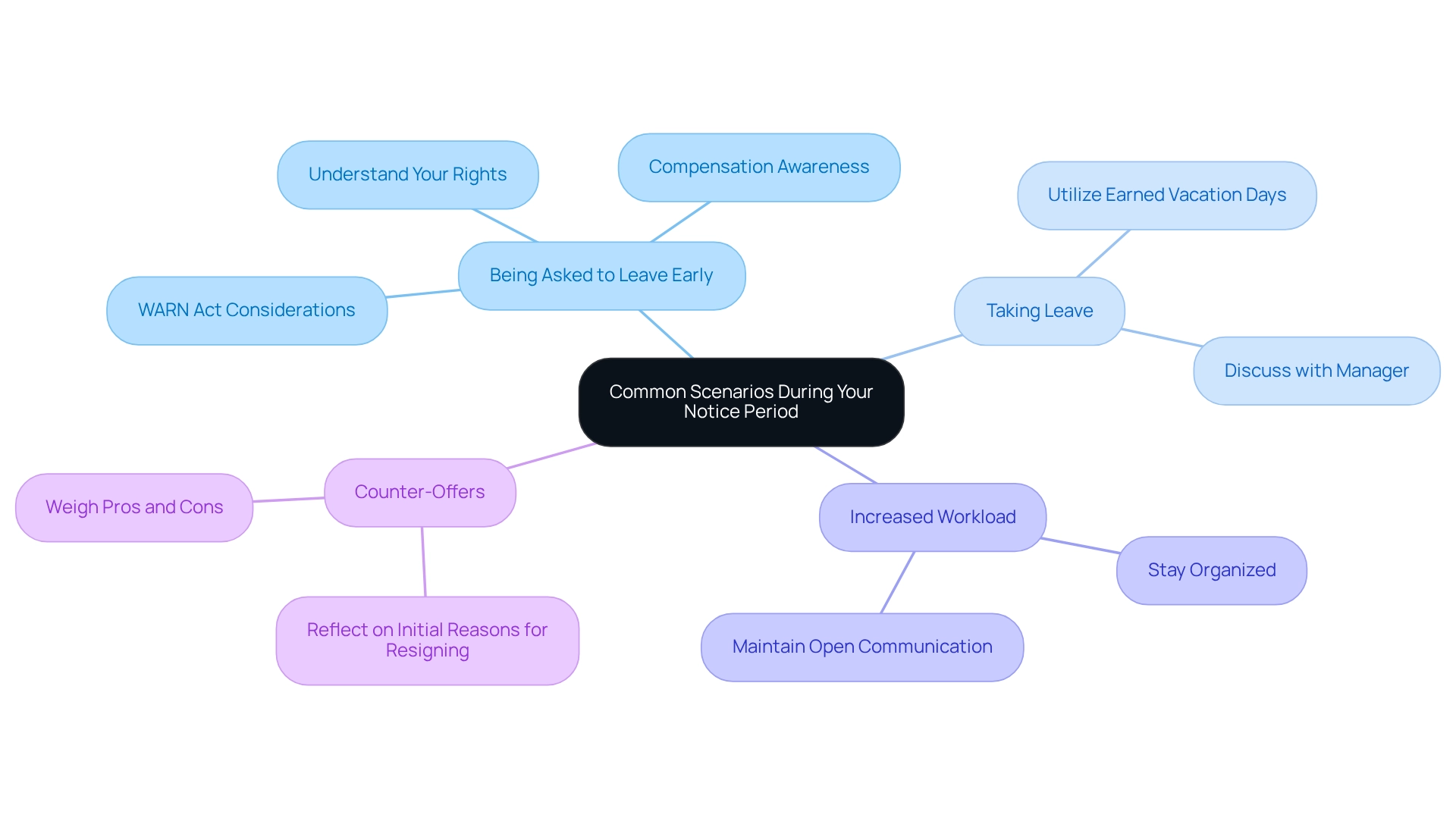
Maintaining Professionalism: How to Leave on Good Terms
To leave your job on good terms, it is crucial to provide notice to your employer and consider the following best practices:
- Communicate Clearly: Transparency is essential when resigning. Clearly articulate your reasons for leaving while maintaining a professional tone. Avoid disparaging remarks about the company or colleagues, as this can tarnish your reputation.
- Express Gratitude: Acknowledge the opportunities and experiences gained during your tenure. Thank your employer and colleagues for their support, as this fosters goodwill and strengthens professional relationships.
- Offer to Help: Demonstrating a willingness to assist in the transition can leave a lasting positive impression. Offer to train your replacement or help wrap up ongoing projects, showcasing your commitment to the team’s success even as you depart.
- Stay Engaged: Maintaining connections with colleagues and supervisors post-resignation can be beneficial for future networking opportunities. Regularly check in and engage with your professional network to keep relationships alive.
Importance of Professionalism in Resignations
Maintaining professionalism during your resignation is paramount. Statistics suggest that a considerable portion of workers believe that providing notice to their employer when exiting a job can influence their future career prospects. In fact, a survey revealed that 70% of HR professionals emphasize the importance of leaving on good terms, which includes the necessity to give notice to an employer, as it can influence references and networking prospects. Furthermore, implementing staff retention strategies, such as offering lateral job opportunities and remote work options, can help sustain positive relationships during resignations.
Expressing gratitude not only enhances your reputation but also positively affects employer-staff relationships when you provide notice after your departure. Acknowledging your employer’s contributions can lead to a more amicable exit and potential future collaborations. This is especially pertinent in the financial sector, where maintaining a robust professional network is crucial.
Best Practices from Career Experts
Career specialists recommend that staff focus on the following when resigning:
- Plan Your Exit: Prepare for your resignation by considering the timing and method of communication.
- Document Your Contributions: Leave behind a summary of your achievements and ongoing projects to assist your team.
- Seek Feedback: Before leaving, ask for feedback on your performance, which can provide valuable insights for your future roles. This aligns with a case study indicating that 92% of workers believe that workplace training positively impacts their job engagement, emphasizing the importance of effective training in enhancing staff satisfaction and engagement.
Examples of Companies Encouraging Positive Exit Experiences
Many organizations actively promote positive exit experiences. For instance, companies such as Google and Salesforce have implemented exit interview procedures that foster open communication, enabling departing staff to share their experiences and recommendations for enhancement. This not only assists the organization but also ensures that staff members feel appreciated until their last day.
As noted by David Mullin, comprehending workplace culture is essential, as it can greatly influence resignations and the overall staff experience.
By following these best practices, you can ensure a smooth transition and uphold a positive professional reputation, which is invaluable in today’s competitive job market. Boutique Recruiting’s impressive track record of success underscores the importance of leaving on good terms, aligning with the firm’s reputation as a trusted partner in the recruiting industry.
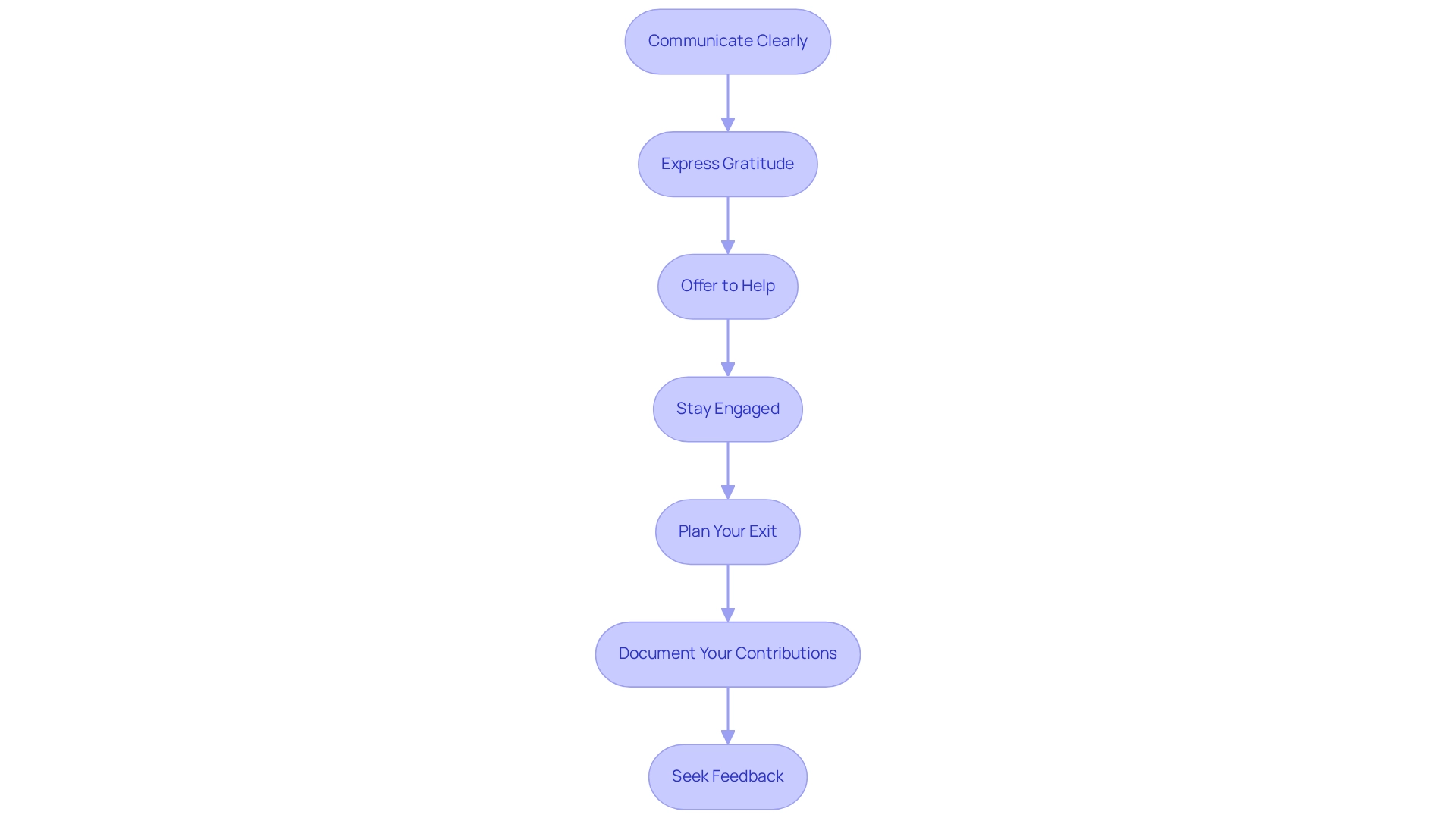
After the Resignation: Preparing for Your Next Career Move
After resigning, it is crucial to provide notice to your employer and concentrate on your next career steps for a smooth transition into your next role.
Update Your Resume: Reflect on your recent experiences and accomplishments. Tailor your resume to emphasize the skills and achievements that are most relevant to your desired position, ensuring it aligns with your long-term career goals.
Network Effectively: Reach out to former colleagues and industry contacts. Networking is a powerful tool that can lead to job opportunities and provide valuable insights into your field. According to career coaches, maintaining connections can significantly enhance your job search success. With an average of 4 million Americans quitting their jobs every month, effective networking is more important than ever.
Research Opportunities: Begin exploring job openings that align with your career aspirations. Utilize job boards, company websites, and recruitment agencies to identify potential roles that fit your skills and interests. Remember, the first job offer might not always be the best; exploring multiple options can reveal opportunities that better align with your values and career goals. It’s essential to consider whether a job aligns with your career goals and values before making a decision.
Prepare for Interviews: Practice common interview questions and be ready to discuss your reasons for leaving your previous job in a positive light. This preparation can help you present yourself confidently to potential employers. Embrace transparency during interviews by being honest about your motivations and workstyle preferences, which can build trust with hiring managers. Be cautious of committing too quickly to a job offer, as this may lead to regret if the position does not meet your expectations.
Consider Further Education: If relevant, think about pursuing additional training or certifications that can boost your employability and make you a more attractive candidate in your field.
Action Steps:
- Set Clear Goals: Define what you want in your next role and create a strategic plan to achieve those objectives. This clarity will guide your job search and networking efforts, ensuring you align your next career move with your personal and professional growth aspirations.
- Maintain a Positive Outlook: Focus on the opportunities that lie ahead rather than dwelling on your previous job. A positive mindset can significantly impact your job search and networking interactions.
Remember, organizations that enhance their staff value propositions often see improved retention rates, highlighting the importance of aligning your next career move with your aspirations. Statistics indicate that the average time taken to find a new job after giving notice can vary, but many professionals find success within a few months. Additionally, a 16% decrease in retention rates occurs for employees who are uncomfortable giving upward feedback, emphasizing the importance of maintaining positive relationships and open communication during your transition. By taking these steps, you can effectively navigate your career transition and position yourself for success. Boutique Recruiting is here to support you in this journey.
Conclusion
Understanding the nuances of notice periods is crucial for both employees and employers, particularly in today’s dynamic workforce landscape. Notice periods are not merely formalities; they play a significant role in ensuring smooth transitions and maintaining professionalism. Factors such as company policies, individual roles, and industry standards greatly influence the expected length of notice, reinforcing the importance of being informed about one’s contractual obligations.
Effective communication during the resignation process is essential. By expressing gratitude, providing clear notice, and assisting with the transition, employees can leave on good terms, which is vital for future career opportunities. Navigating the challenges of a notice period with professionalism and positivity can significantly impact workplace relationships and personal reputation.
In conclusion, understanding notice periods and adhering to best practices can facilitate a respectful and professional exit from any position. As the employment landscape continues to evolve, both employees and employers benefit from fostering positive relationships, ultimately contributing to a more harmonious work environment. By prioritizing professionalism during resignations, individuals can pave the way for future successes while leaving a lasting positive impression on their organizations.
Frequently Asked Questions
What is a notification duration in the context of resigning from a job?
A notification duration refers to the time a worker is obligated to continue working after officially resigning, typically ranging from two weeks to a month, influenced by company policy and the employee’s specific role.
Why is it important to understand your notification duration?
Understanding your notification duration is essential as it reflects professionalism and allows the organization sufficient time to find a replacement and ensure a smooth transfer of duties.
What is the average notification duration in the U.S. as of 2025?
The average notification duration in the U.S. is generally two weeks, although it can vary based on industry standards and individual employment contracts.
How do specific roles affect the length of the notification duration?
Certain roles, especially in leadership positions or specialized fields, may require a longer notification duration to facilitate a smooth transition of responsibilities.
What should employees do to ascertain their specific notification duration?
Employees should familiarize themselves with their employment agreement or company manual to determine the exact notification duration relevant to their circumstances.
What are the potential consequences of not adhering to notification durations?
Not adhering to notification durations can harm professional relationships, potentially affecting future recommendations and career prospects.
What factors can influence the length of a notice period?
The length of a notice period can be influenced by company policy, role and seniority, current projects, industry standards, and personal circumstances.
How do industry standards vary regarding notification durations?
Different sectors have varying guidelines for notification durations; for example, management and professional roles often require longer notice periods compared to service occupations.
What should an employee consider if they are involved in key projects before resigning?
Employees should assess how their departure might impact ongoing projects and discuss with their manager to determine a suitable timeframe for giving notice that minimizes disruption.
How can personal circumstances affect the notice period?
Individual situations, such as receiving a new job offer or relocating, may affect how much notice an employee can realistically provide, which requires balancing personal needs with professional obligations.
